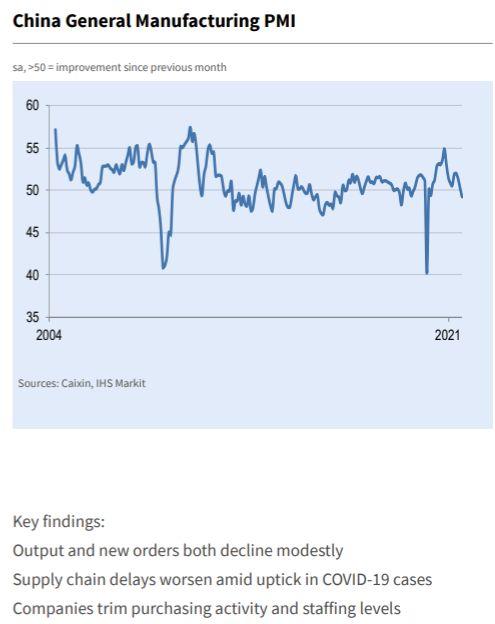Slips into contraction
The commentary on the results from Markit is extensive, reproduced below. Bolding is mine:
- “The Caixin China General Manufacturing PMI came in at 49.2 in August, down from 50.3 the previous month and falling into contractionary territory for the first time since April 2020. The reappearance of Covid-19 clusters in several regions beginning in late July has dealt a blow to manufacturing activity.
- “Both supply and demand in the manufacturing sector shrank as the Covid-19 outbreaks disrupted production. The gauges for output, total new orders and new export orders all dropped into negative territory. Output shrank for the first time since February 2020. Demand for intermediary products and investment goods also dropped, while that for consumer goods was relatively stable. Exports fell amid logistics disruptions and as the pandemic continued overseas.
- “The job market shrank slightly amid the Covid-19 pressure. The subindex for employment fell into contractionary territory for the first time in five months, leading to a rise in backlogs of work.
- “Inflationary pressure remained high. Input costs rose for the 15th month in a row and the growth rate accelerated in August after slowing for two consecutive months. Transportation costs rose and raw material prices remained high. The gauge for output prices stayed in expansionary territory, but growth was moderate. Some surveyed manufacturers said demand was sluggish due to the pandemic and their ability to pass rising costs onto clients was limited.
- “Suppliers’ delivery times continued rising as measures to contain the Covid-19 outbreaks disrupted logistics and some suppliers experienced raw material shortages. The gauge for delivery times hit the lowest point since February. The quantity of purchases dropped amid the sluggish market,
- ”The latest Covid-19 resurgence has posed a severe challenge to the economic normalization that began in the second quarter of last year. Manufacturing shrank in August as both supply and demand weakened. Meanwhile, overseas demand also dropped. The job market weakened slightly, though it managed to maintain overall stability. Manufacturers cut purchases, leading to a rise in stocks of finished goods.
- ”Meanwhile, raw material prices remained high along with inflationary pressure. Surveyed manufacturers remained optimistic about the business outlook, but the gauge for future output expectations stayed below the long-term average.
- “Official economic indicators for July were worse than the market expected, indicating mounting downward pressure on economic growth. Authorities need to take a holistic view and balance containing Covid-19, stabilizing the job market, and maintaining stability in supply and prices.”
Earlier:
This article was originally published by Forexlive.com. Read the original article here.
